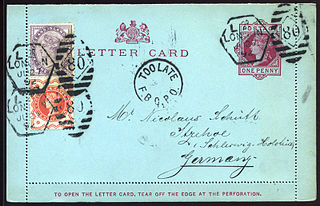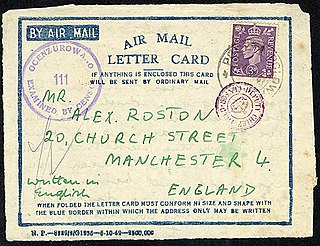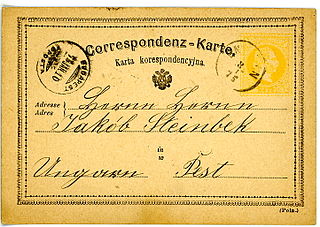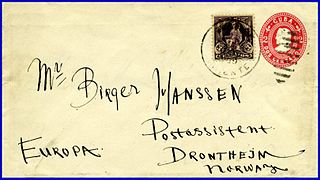 W
WA piece of postal stationery is a stationery item, such as a stamped envelope, letter sheet, postal card, lettercard, aerogram or wrapper, with an imprinted stamp or inscription indicating that a specific rate of postage or related service has been prepaid. It does not, however, include any postcard without a pre-printed stamp.
 W
WAn aerogram, aerogramme, aérogramme, air letter or airletter is a thin lightweight piece of foldable and gummed paper for writing a letter for transit via airmail, in which the letter and envelope are one and the same. Most postal administrations forbid enclosures in these light letters, which are usually sent abroad at a preferential rate. Printed warnings existed to say that an enclosure would cause the mail to go at the higher letter rate.
 W
WThe term corner card means the wording, sometimes with a pictorial feature, in the upper left hand corner of a postal stationery envelope or an envelope designed to have regular adhesive stamps affixed to it. It is there for the purpose of stating the sender's return address to facilitate the return of undeliverable mail.
 W
WIn philately, a cut square is an imprinted stamp cut from an item of postal stationery such as a stamped envelope, postal card, letter sheet, letter card, aerogram or wrapper in a square or rectangular shape. An alternative use of the term is simply any stamp, from sheets or postal stationery, cut in a square or rectangular shape and not cut to shape.
 W
WCut to shape is a philatelic term referring to a postage stamp or postal stationery indicium that has been cut to the shape of the design, such as an octagon, circle or oval, instead of simply cut into a square or rectangular shape.
 W
WThe term formular is an adjective applied to envelopes, cards and aerograms, etc., produced by postal authorities or to their specification, but bearing no imprinted or embossed stamp or other indication of prepayment of postage.
 W
WIn philately, an imprinted stamp is a stamp printed onto a piece of postal stationery such as a stamped envelope, postal card, letter sheet, letter card, aerogram or wrapper. The printing may be flat upon the surface of the paper, or embossed with a raised relief. An imprinted stamp is also known as unadhesive stamp or indicium.
 W
WIn philatelic terminology a letter sheet, often written lettersheet, is a sheet of paper that can be folded, usually sealed, and mailed without the use of an envelope, or it can also be a similar item of postal stationery issued by a postal authority. Letter sheets derive from the form in which written correspondence was made up before the mid-19th century — letters were written on one or more sheets of paper that were folded and sealed in such a way that the address could be written on the outside.
 W
WIn philately a lettercard or letter card is a postal stationery item consisting of a folded card with a prepaid imprinted stamp. The fact that it is folded over gives the writer twice as much room for the message compared with a postal card. The message is written on the inside and the card is then folded and sealed around the edges. The recipient tears off and discards the perforated selvages to open the card.
 W
WMulready stationery describes the postal stationery letter sheets and envelopes that were introduced as part of the British Post Office postal reforms of 1840. They went on sale on 1 May 1840, and were valid for use from 6 May. The Mulready name arises from the fact that William Mulready, a well-known artist of the time, was commissioned to illustrate the part of the letter sheets and envelopes which corresponded with the face area.
 W
WThe Penny Penates is a postcard that was posted on 14 July 1840 to Fulham in London. It was addressed to the writer and practical joker Theodore Hook, who was probably also its sender and artist. The hand-painted design on the postcard shows an image of post office clerks sitting around a giant ink well.
 W
WPostal cards are postal stationery with an imprinted stamp or indicium signifying the prepayment of postage. They are sold by postal authorities. On January 26, 1869, Dr. Emanuel Herrmann of Austria described the advantages of a Correspondenz Karte. By October 1, 1869 the world's first postal card was produced by Austria-Hungary. They caught on quickly. By the end of 1870, Great Britain, Finland, Switzerland and Württemberg joined the countries issuing postal cards. In the United States, they were first produced in 1873. Some of the forms taken by postal cards include the regular single card which may be commemorative or definitive, attached message-reply cards, airmail postal cards, and official postal cards used for official government business with a "penalty for private use".
 W
WA postcard or post card is a piece of thick paper or thin cardboard, typically rectangular, intended for writing and mailing without an envelope. Non-rectangular shapes may also be used but are rare. There are novelty exceptions, such as wooden postcards, copper postcards sold in the Copper Country of the U.S. state of Michigan, and coconut "postcards" from tropical islands.
 W
WThe Sherborn Collection is a collection of 1841-85 Queen Victoria embossed 1d pink postal stationery stamped envelopes that forms part of the British Library Philatelic Collections. The collection was formed by C. Davis Sherborn and donated to the British Museum in 1913.
 W
WA stamped envelope or postal stationery envelope (PSE) is an envelope with a printed or embossed indicium indicating the prepayment of postage. It is a form of postal stationery.
 W
WIn philately a wrapper is a form of postal stationery which pays the cost of the delivery of a newspaper or a periodical. The wrapper is a sheet of paper, large enough to wrap around a folded or rolled newspaper and with an imprinted stamp to pay the cost of postage. Some catalogs and reference books refer to a wrapper as postal bands which comes from the French term bandes postale. Still others refer to it as a newspaper wrapper or periodical wrapper.
 W
W